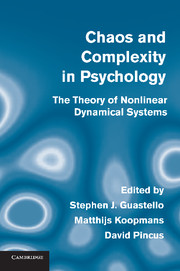Book contents
- Frontmatter
- Contents
- Contributors
- Preface
- 1 Introduction to Nonlinear Dynamics and Complexity
- 2 Collective Intelligence: Observations and Models
- 3 Neurodynamics and Electrocortical Activity
- 4 Psychophysics
- 5 Temporal and Spatial Patterns in Perceptual Behavior: Implications for Dynamical Structure
- 6 Embodied and Embedded: The Dynamics of Extracting Perceptual Visual Invariants
- 7 Origins of Order in Cognitive Activity
- 8 Nonlinear Complex Dynamical Systems in Developmental Psychology
- 9 Developmental Psychopathology: Maladaptive and Adaptive Attractors in Children's Close Relationships
- 10 Psychopathology
- 11 Coherence, Complexity, and Information Flow: Self-Organizing Processes in Psychotherapy
- 12 The Dynamics of Human Experience: Fundamentals of Dynamical Social Psychology
- 13 Group Dynamics: Adaptation, Coordination, and the Emergence of Leaders
- 14 Organizational Psychology
- 15 Complexity, Evolution, and Organizational Behavior
- 16 Agent-Based Modeling Within a Dynamic Network
- 17 Epilogue: Psychology at the Edge of Chaos
- Index
5 - Temporal and Spatial Patterns in Perceptual Behavior: Implications for Dynamical Structure
Published online by Cambridge University Press: 18 December 2013
- Frontmatter
- Contents
- Contributors
- Preface
- 1 Introduction to Nonlinear Dynamics and Complexity
- 2 Collective Intelligence: Observations and Models
- 3 Neurodynamics and Electrocortical Activity
- 4 Psychophysics
- 5 Temporal and Spatial Patterns in Perceptual Behavior: Implications for Dynamical Structure
- 6 Embodied and Embedded: The Dynamics of Extracting Perceptual Visual Invariants
- 7 Origins of Order in Cognitive Activity
- 8 Nonlinear Complex Dynamical Systems in Developmental Psychology
- 9 Developmental Psychopathology: Maladaptive and Adaptive Attractors in Children's Close Relationships
- 10 Psychopathology
- 11 Coherence, Complexity, and Information Flow: Self-Organizing Processes in Psychotherapy
- 12 The Dynamics of Human Experience: Fundamentals of Dynamical Social Psychology
- 13 Group Dynamics: Adaptation, Coordination, and the Emergence of Leaders
- 14 Organizational Psychology
- 15 Complexity, Evolution, and Organizational Behavior
- 16 Agent-Based Modeling Within a Dynamic Network
- 17 Epilogue: Psychology at the Edge of Chaos
- Index
Summary
Introduction
Perception and action are continuously changing processes unfolding in space and time. Their seamless coordination with the surrounding environment gives the impression that they are part of a unitary system efficiently integrating incoming sensory information with prior experience. Critical to understanding such fluid systems is the need to learn how behavioral patterns evolve over time, are time-dependent, and how they scale (assume a particular proportionality or nonproportional relation) with their surrounding context. Moreover, we need to learn how internal states and external conditions modify these patterns so that even dramatic shifts in behavior can be explained by a common mechanism. Nonlinear dynamical systems (NDS) theory and its tools offer the means to study such ever-changing systems. The aim here is to illustrate the relevance of NDS to perceptual and related cognitive–motor problems using visual search as a working example. I also hope to show how the use of NDS tools can escape some of the impasses of traditional cognitive approaches. Although perceptual behavior is the focus here, the logic and theory extend to all forms of behavior, with the presumption that sensation, perception, and cognition lie on a continuum of a common mental system, one that is emergent from the complex short- and long-range interactions across neural ensembles of the human brain.
- Type
- Chapter
- Information
- Chaos and Complexity in PsychologyThe Theory of Nonlinear Dynamical Systems, pp. 132 - 176Publisher: Cambridge University PressPrint publication year: 2008



